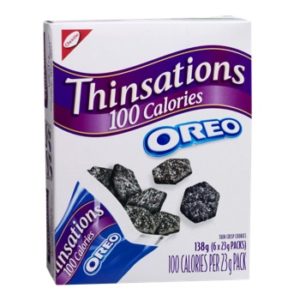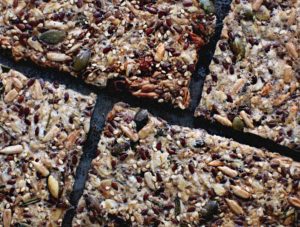Snack Smarter: Cracking down on crackers
Snack Smarter:
Cracking down on crackers.
If you’ve ever had a big bowl of soup as a kid you know that crackers are an essential addition! The little wafers are full of crunch, flavor and can go almost anywhere. It seems perfect for those of us on the go- and are especially easy for parents to throw some in a lunch box for kids. Not to mention, they seem healthy enough, right? Well, today we are cracking down on crackers and learning about how to make healthier choices for families.
The heavy hitters of the snacking industry already know how much you love convenience and how much your family loves flavor. Nowadays, they have gotten wise to our love for health. We want our family to eat our best and feel our best. So, snacking giants like Nabisco have came up with a brilliant solution: create healthier snacks. Or- that’s what they would want us to think.
Snacks have began to be re-br anded to portray a variety of “healthiness”. Oreo’s can now be found in a box called ‘Thinsations’ (100 calories or less) and the sugariest of breakfast cereals are being stuffed into a granola bar and branded as healthy. Special K has even (unsuccessfully) tried to brand themselves as ‘feminist’ by showing women eating and telling them to “own it”. Well, they aren’t fooling us!
anded to portray a variety of “healthiness”. Oreo’s can now be found in a box called ‘Thinsations’ (100 calories or less) and the sugariest of breakfast cereals are being stuffed into a granola bar and branded as healthy. Special K has even (unsuccessfully) tried to brand themselves as ‘feminist’ by showing women eating and telling them to “own it”. Well, they aren’t fooling us!
With all these misleading snacks, why crack down on crackers?
We’ve noticed crackers get off easy as they aren’t as glamorized as other snacks. So, it’s time to shed some light on why crackers are just as bad- and how we can make better choices.
As nutritional information differs on each cracker, there are three main things you want to look for: trans fats, sodium, sugar, fat, salt and artificial flavors/colors.
Trans fats
- These are irrefutably the worst kinds of dietary fat because they increase “bad” LDL cholesterol that raises risk of heart disease, stroke, diabetes and other chronic inflammation. Research from the Harvard School of Public Health says that for every 2% of calories from trans fat consumed daily, the risk of heart disease raises by 23%. Avoiding them is important, but sometimes tricky to do. Even if the section in the nutritional chart says 0 g trans fats, it means that per serving, there is less than 0.5 g trans fats, and the label does not have to disclose it. Sometimes serving sizes are so small they don’t give us a real idea of what we’re getting in our food. Get wise to these tricks and look at the ingredients list; if you find the word “hydrogenated” it means the product contains trans fats.
High-fructose corn syrup (HFCS)
- This doesn’t sound like “sugar”, but HFCS is a liquid sweetener made from cornstarch that tastes even sweeter than pure table sugar (sucrose). In Canada, HFCS is sometimes labeled as glucose-fructose. This ingredient can cause bloating and gas in the digestive tract and worsen conditions like irritable bowel syndrome. Like sugar, HFCS hurts your long-term health because it adds calories, spikes blood sugar levels, and contributes to insulin resistance and diabetes. Additionally, the only organ that can metabolize fructose is the liver. Too much fructose can overload these cells and lead to non-alcoholic fatty liver disease (NAFLD)5. NAFLD is a rising health concern among our children.
Research from the Harvard School of Public Health says that for every 2% of calories from trans fat consumed daily, the risk of heart disease raises by 23%.
Sugar, fat and salt
- It is the “trifecta” of deliciousness, and the food industry knows it. They manipulate the levels of sugar, fat and salt in food so that their foods are so good they become addictive. This response is scientifically developed to trigger a dopamine release, similar to the reward of drinking alcohol. Similarly, it can lead to the same addictive behaviors of reaching for more and more6. A 2013 book by Michael Moss talks about this addictive phenomenon in his book Salt, Sugar, Fat7. Processed crackers have these three elements in ratios designed to make you want more, not to mention the direct health impacts of increased blood pressure from high sodium, increased insulin resistance from sugar, and high blood triglycerides from fat.
So instead of traditional boxed and processed crackers, what can you snack on? A few cracker options with more healthy ingredients and good taste and crunch are:
- Mary’s Original Organic Crackers
- Kashi Original 7 Grain Sea Salt Pita Crisps
- Wasa Krispbread Sourdough Rye Crackers or Light Rye Crackers
- Or better yet, make your own crackers at home!

Life Changing Cracker Recipe
The “Life Changing” crackers contain sunflower, flax, pumpkin, sesame and chia seeds. Plus, oats, psyllium husks, maple syrup and coconut oil or ghee. They still hit your “OMG” response, but without the additional junk that goes straight to your trunk! Plus you can add your favorite herbs and spices to suit your tastes, like rosemary, garlic and smoked salt. Yum!
View the recipe
References
- Mozaffarian, D., Katan, M. B., Ascherio, A., Stampfer, M. J., & Willett, W. C. (2006). Trans fatty acids and cardiovascular disease. New England Journal of Medicine, 354(15), 1601-1613.
- https://www.health.harvard.edu/staying-healthy/the-truth-about-fats-bad-and-good
- http://www.health.com/health/gallery/0,,20533295,00.html#frozen-dinners-0
- https://www.eatrightontario.ca/en/Articles/Carbohydrate-and-Sugar/What-you-need-to-know-about-high-fructose-corn-syr.aspx
- https://www.health.harvard.edu/press_releases/too-much-fructose-a-hazard-for-heart-health
- https://foodaddictioninstitute.org/scientific-research/physical-craving-and-food-addiction-a-scientific-review/
- http://www.michaelmossbooks.com/
- http://www.huffingtonpost.co.uk/entry/special-k-women-eat-advert-tries-and-fails-to-be-feminist_uk_592690cee4b062f96a340f80



